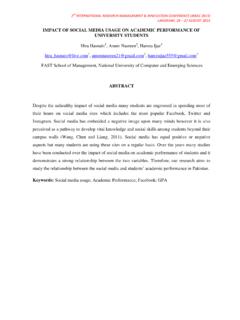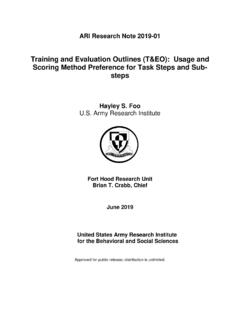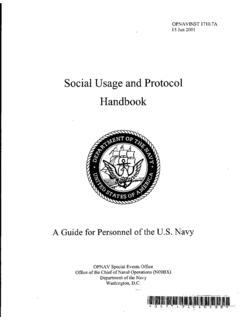Transcription of High School Students’ Social Media Usage Habits
1 Journal of Education and Practice ISSN 2222-1735 (Paper) ISSN 2222-288X (Online) , , 2017 99 high School students Social Media Usage Habits Assoc. Prof. Erdo an TEZC Bal kesir University, Faculty of Education Ress. Asst. Mustafa EN Y ld z Technical University, Faculty of Education Abstract Social Media which is an important product of Computer and Internet Technologies has a growing Usage level day by day. Increasing Social Media Usage level gives opportunity for new software developments and making investments in this area. From this aspect, therefore, Social Media has not only economic function but also make persons participate in Social life. Furthermore, it also provides opportunities for undemocratic actions and operations as in terms of democratic society life. Identifying users Habits has an important function on determining economic, Social and cultural effects of Social Media .
2 From this perspective, this research aims to determine Social Media Usage Habits of high School students . The data was collected from 853 students in total (419 female and 434 male). In research, Frequency of Social Media Instruments Usage Scale for determining Usage frequency of 10 different Social Media instrument, and to determine the reasons of these instruments Usage Reasons of Social Media Usage Scale consisting of 20-item are used for collecting data. Scales are also rated on 5-point scale. The results show that the most commonly used Social Media among the students participating in questionnaire is Youtube , and Facebook follows it in the second place. MySpace and LinkedIn are the least used Social Media sites. Top reasons of students Social Media Usage are sharing document, information and opinion, and entertainment. It was determined that students do not use Social Media instrument for presenting themselves by using others profiles too much.
3 Gender differences has an important impact on Social Media Usage . students access and use Social Media mostly with using their smartphones. students spend between 1-3 hours daily on Social Media . Keywords: Social Media , H gh School students , Technology Usage Habits , Educational Usage of Social Media Introduction A rapid change and development is observed in both software and hardware as a result of the innovative nature of Computer and Internet technologies. Social Media is one of these. Social Media is used as a wide definition of various network tools and technologies that emphasize the Social characteristics of the internet as the communication and cooperation instrument of the 21st century which resulted from the developments in internet technologies. Although Social Media , which is a rapidly improving field, is dated back to 1969 when CompuServe was used as an online service (Banks, 2007), it can be considered that it began in 1997 in the modern sense in which the internet offered users to create their own profiles and make friends with other people (Boyd and Ellison, 2007).
4 At the end of the 1990 s, people began sharing messages, photos, and videos with each other through their own blogs. Together with the increase in the Usage degree that occurred as a result of the establishment of Facebook in 2004, YouTube in 2005, Slideshare and Twitter in 2006, it was observed that Social Media settings, which served for various fields, were improved (Boyd and Ellisoni 2008; Dao, 2015; Grosseck and Hotescu, 2008). In general, Social Media includes Web or interactive internet-based applications that are interchangeably used as Social software (Obar and Wildman, 2015). Kaplan & Haenlein (2010: 61) define Social Media as Social Media is a group of Internet-based applications that build on the ideological and technological foundations of Web , and that allow the creation and exchange of User Generated Content . According to another definition, Social Media is a broad term consisting of blogs, microblogs, forums, dialogues, images, sounds, videos, networks, Social web profiles and other Social networks (Eley and Tilley, 2009: 78).
5 It is possible to consider Social Media as a comprehensive umbrella term consisting of network-based applications that enable users to create their own contents through Social means and share these as texts, audio, video, image settings individually or in groups. Although there are different definitions and explanations about Social Media , these definitions emphasize the increasing function of Social Media . These functions can be listed as; Social Media websites being web-based sites that allow for Social communication, the users being able to create online communities and share information with these communities as well as allowing for a two-way communication. With respect to educational processes, they can be listed as; enabling interaction between teachers and students , creating materials and allowing the students to share materials with each other and their teachers etc. (Boyd and Ellison 2007; Dabbah and Rao, 2011; Dan, 2015; Duffy and McDonald, 2011, Tonbulo lu and man, 2014).
6 With these features, Social Media is competent in responding to the demands that have arisen from the change in today s Journal of Education and Practice ISSN 2222-1735 (Paper) ISSN 2222-288X (Online) , , 2017 100 understanding in learning. Today, learners are no longer passive receivers of information but active creators of their own meanings. Leaners create their own contents. Learning by means of Social Media contributes to learners motivations. In addition, as an internal part of a rich School experience, it supports the informal side of teachers, self-orientation and self-determination of the learners (Dabbah and Kitsantas, 2012; Grosseck and Hotescu, 2008; Solomon and Schrum, 2007). It offers a learning environment for learners to manage and sustain their own learning.
7 It offers learners a time and space-independent opportunity to contact their peers and to manage their own learning activities (Selwyn, 2007; Solomon and Schrum, 2007). Hansen, Shneiderman and Smith (2011) state that the development and variety in Social Media paved the way for new interaction choices among users and this can assumed to be achieved through hundreds of Social Media settings such as sharing texts, photos and videos (Churchill, 2009). That Social Media can be used through mobile devices, that it is interaction, user and society-based and that it is user-friendly have been effective in it becoming widespread (Ada, i ek and Kaynakye il, 2013; Hanna, Rohn and Crittenden, 2011). However, in the study conducted by Perrin during 2005-2015 on Social Media Usage profiles, it was stated that 65% of American teenagers are Social Media users. Researches on Social Media settings (Grosseck and Hotescu, 2008; Kabilan, Ahmad and Abidin, 2010; Lenhart, Purcell, Smith and Zickuhr, 2010; McCool, 2011; Wright, 2010) have shown that Social Media can be used in administrative processes, Social needs, searching for information and entertainment for educational purposes.
8 Dabbagh and Kitsantas (2011) state that Social Media supports formal and informal learning and enables learners to arrange their own personal learning settings. According to a study conducted on Social Media Usage Habits (Ada et al., 2013; Fern ndez, 2011; Kocadere and A kar, 2013; Lenhart et al., 2010; Li, Bernoff, Pflaum and Glass, 2007; ener, 2009; Vural and Bat, 2010) it was observed that Social Media was used mostly for commenting on others profiles, reading blog posts, listening to music, making friendship requests, examining someone else s status and participating in various Social , educational etc. activities. Kamilo lu and Yurtta (2014) conducted a study on Turkish Culture and emphasized that the most commonly used Social Media was Facebook and was primarily used for acquiring information, entertainment and as a free time activity. Studies in the literature (Chaffey, 2016; Perrin, 2015) show that use of Social Media is increasing.
9 There is an increase in the use of Social Media parallel with the increase in the variety of Social Media tools. In addition, studies suggest that there is a constant increase in Social Media Usage (Anderson and Rainie, 2012) and that teenagers have a higher level of Social Media Usage than adults (Fern ndez (2011; Lenhart et al., 2010; ener, 2009). When this variety and increase is considered, identifying which purposes Social Media is used for by teenagers will contribute to its effective use in the students learning-teaching processes. Thus, it will contribute to educational leaders in developing policies and to teachers as implementers in designing the teaching-learning processes. In addition, it will shed light on clarifying student behaviors in high School with respect to Social Media . Based on the fact that determining student purposes on using Social Media will contribute to measures taken against harmful effects such as cyber violence, inappropriate content, schism and security (O Keeffe and Clarke-Pearson, 2011), the study aimed at determining the relationship between high School students Social Media Usage frequency and purposes and these variables.)
10 Participants There were three different samples in the study. The first and second samples were collected in February, 2015. The first sample was used in conducting the Exploratory Factor Analysis (EFA) and reliability analysis. This group consisted of 217 high School students . 146 ( ) of the students were male and 71 ( ) were female. The second sample was used in conducting the Confirmatory Factor Analysis (CFA). Along with various other opinions, some researchers (Anderson and Gerbing, 1988; Kline, 2011) underlined that it is not appropriate to conduct both EFA and CFA on the same data set. Thus, CFA was decided to be carried out in the study with the data collected from 220 students . Among the students participating in the second sample of the study, 138 ( ) were male and 82 ( ) were female. The third sample was collected after the EFA and CFA. The third sample was collected to shed light on the purpose of this study. The data from the third sample were collected in May-June term of 2016.















